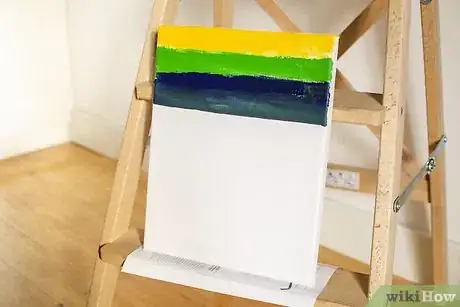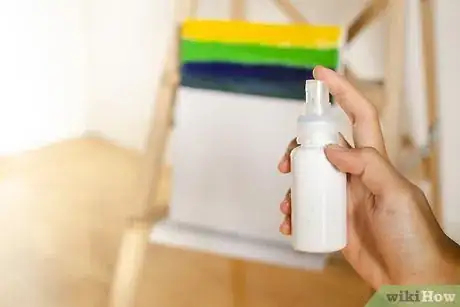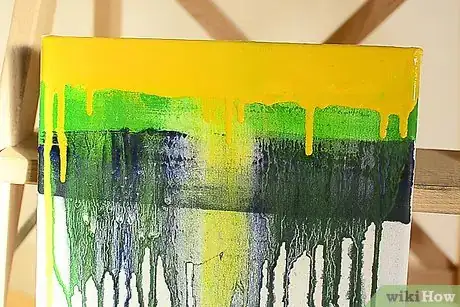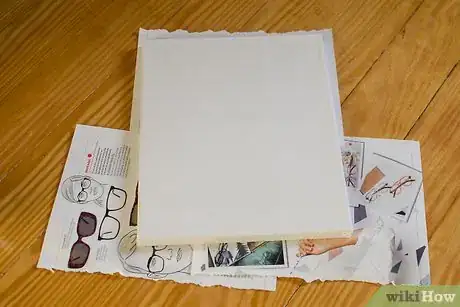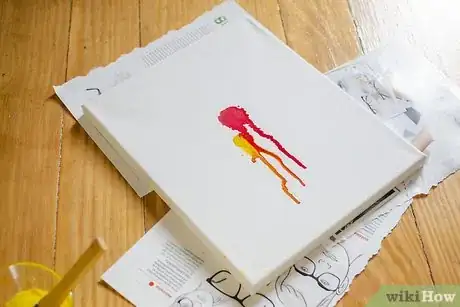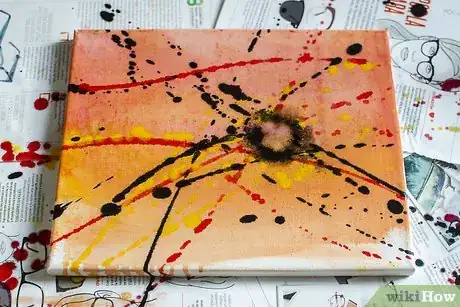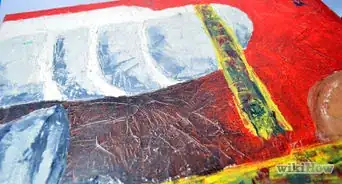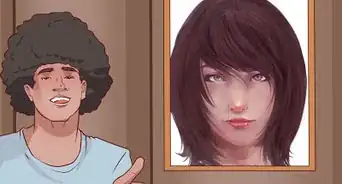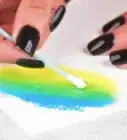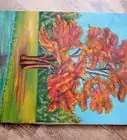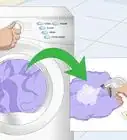This article was co-authored by Rebecca Schweiger and by wikiHow staff writer, Jessica Gibson. Rebecca Schweiger is a Professional Artist, Published Author, and the Founder of The Art Studio NY, New York City's #1-rated art school and global online art studio. Celebrated by TV networks, press, and celebrities including NBC, ABC, E!, Time Out New York, The Kardashians, and Big Bang Theory's Jim Parsons, Rebecca specializes in creating abstract artwork and teaching studio art classes. Her art studios provide 100+ weekly, beginner-friendly drawing and painting art classes to people around the globe. With more than 22 years of art experience, she is the author of Release Your Creativity: Discover Your Inner Artist with 15 Simple Painting Projects, and her artwork has been exhibited in more than 50 museums and galleries around the world. Rebecca holds a BFA in Painting from Boston University's School for the Arts and has participated in acclaimed artist residencies worldwide.
There are 17 references cited in this article, which can be found at the bottom of the page.
This article has been viewed 23,067 times.
Most artists reach for acrylic paint to make drip effects, but it is possible to make oil paint run. As long as you're working with oil paint while it's still wet, you can spray, brush, or pour solvent onto the painting to get your desired effect. To get widespread or abstract drips, spray your canvas with turpentine. If you'd like a little more control over where the paint runs, mix the paint with extra medium and brush it on the canvas. For a rippled effect, pour the paint on the canvas and tilt it. Any of these techniques are great for creating backgrounds or abstract designs.
Steps
Spraying Turpentine on a Painting
-
1Hang your canvas and create an oil painting. Put your canvas in front of a drop cloth or set it on an easel. If you're using an easel, hang a drop cloth behind it so you don't damage the wall. Set the painting up so it's at a 90- to 1200-degree angle and create any style of painting that you like. For a modern or abstract painting, make large horizontal bars of color.[1]
- You could also paint a subject or landscape. Keep in mind which area you'd like to add a dripping effect to. For example, you might paint a large window with panes so you can spray and create raindrops on it.
-
2Fill a spray bottle with turpentine and set a drip tray below the canvas. Set a funnel onto a spray bottle and pour in turpentine to fill it at least halfway. Screw on the spray top so it's ready to use. Then, put a plastic tub or container under the canvas to catch the turpentine and oil paint as it drips off of your canvas.[2]
- Work in a well-ventilated space or outdoors to minimize breathing in the fumes. If you get turpentine on your hands, wash them thoroughly with soap and water.
- If you prefer, work outside against a fence or shed. Then, you can spread drop cloths on the ground to absorb the mess.
Advertisement -
3Spray the painting with turpentine to make the paint run. Turn the spray bottle nozzle tightly to the right to make a narrow, strong burst of turpentine or loosen the nozzle to the left so you get a broad misting of turpentine on the canvas. Stand in front of your oil painting and spray near the top so the paint begins to drip and run. Step back if you want gradual dripping or move closer to the canvas if you want the paint to noticeably run.[3]
- Experiment with spraying your painting until you get the effect you're looking for.
-
4Dry the painting completely before you move it. Don't take the painting down or off of the easel right away since this could cause the wet paint to run in unexpected ways. Instead, leave the painting to dry for at least several days before you move it.
- If you painted inside a studio, keep the window open for ventilation.
Brushing on Thinned Oil Paint
-
1Create an oil painting that you'd like to have a dripping effect. Although you could make a small section of the painting look like it's dripping, this is a great technique for making a dramatic style over the surface of a painting. Make your painting and be prepared to add the dripping oil paint while your painting is still wet.[4]
- Applying a dripping glaze to a portrait gives it a modern or contemporary feel. It's also great for landscapes where you want a wet or blurred effect, such as a rainy street.
-
2Mix medium into oil paint until it drips from the end of your brush.[5] Choose which color of oil paint you'd like to have dripping and squeeze it onto a palette. Then, dip a paintbrush or palette knife into your choice of medium and mix it into the paint. Keep adding a few drops of medium at a time and stop incorporating it once the paint looks runny.[6]
- Light drying oil that contains purified linseed oil and turpentine is a great medium for this method.[7] The turpentine thins the pigments in the oil paint so your thinned paint drips on the canvas easier.
- Remember that oil and water don't mix. So, don't use an acrylic paint medium with oil paint.[8]
Tip: Don't thin the oil paint with a solvent and brush it over the surface of your painting. Although it makes a dripping effect, it can damage your painting so it won't hold up over time. Keep in mind that medium is mainly oil and not a solvent, so it's not as harsh on the canvas.
-
3Dip a brush into the thinned paint and spread it across the top of your painting. Set your painting up on an easel and dip a clean paintbrush into the thinned paint. Slowly brush across the top of your oil painting while it's still wet and press firmly so the paint runs down the painting.[9]
- Let your oil painting dry completely before you hang or varnish it.
- If you'd like to make just 1 area of the painting look like it's dripping, use a smaller brush and paint along the top of that space. Paint just along the bottom edge of storm clouds if you want to create a rain-like effect below them, for instance.
Pouring the Paint and Tilting the Canvas
-
1Prime your canvas with gesso and let it dry. Before you start oil painting, brush an even layer of gesso across the entire canvas. Then, let the canvas dry for as long as the gesso specifies. Usually, this takes at least a couple of days.[10]
- The primer prevents the acidic paint from destroying the surface of the canvas.
- You can use oil-based or acrylic gesso depending on what you have in your studio. Keep in mind that oil-based gesso will last longer than acrylic gesso.
-
2Put equal parts oil paint, liquin, and paint thinner into a small cup. Get out a package of small disposable cups. You'll need 1 cup for each color you want to use on the canvas. To mix a color, pour equal parts of oil paint, liquin, and paint thinner into each cup.[11]
- Liquin is a medium that helps the oil paint dry faster.
- Use turpentine or odorless mineral spirits for your paint thinner, since both of these make the paint drip easier.
-
3Stir the mixture until it's smooth and uniform.[12] Use a palette knife or the end of a paintbrush to mix the oil paint with the liquin and paint thinner. Keep mixing until the paint is thin and you don't see lumps of pigment.[13]
- You could stir the mixture with your paintbrush bristles, but this can clog the bristles with paint.
-
4Pour coin-sized amounts of the mixture onto the flat canvas. Spread a drop cloth or old sheet on your work surface and lay your primed canvas flat on it.[14] Slowly pour a coin-sized amount of the thinned paint directly onto the canvas. If you want to cover the entire canvas to make a background, pour the oil paint about every 2 inches (5.1 cm) across the surface. You can use different colors or a single shade.[15]
- For example, if you want to make a background for an ocean, use different shades of blue.
- If you want to make just a portion of the canvas look like it's dripping, pour a tiny amount of the oil paint on that space.
-
5Tilt the canvas up to make the paint run. Hold the canvas by the sides and tilt one side up so the paint begins to run in the opposite direction.[16] If you want a slight dripping effect, tilt it up about 20-degrees. For really noticeable streaks, lift 1 side of the canvas up to a 40-degree angle.[17]
- You can try this effect on any side of the canvas. If you're making an abstract oil painting, play around with tilting all of the sides so the paint drips and runs in all directions.
-
6Dry the painting for 1 week. Since you used liquin in the thinned oil paint, your painting won't take as long to dry as traditional oil paintings. Lay your painting flat in a well-ventilated room and let it dry completely.[18] Then, you can hang your painting or oil paint onto your new background.[19]
- Experiment by layering more oil paint on your canvas.[20] You could paint a setting sun onto your background of waves, for instance.
Playing Around with the Dripping Effects
-
1Try all of these techniques on a single canvas. The important thing when making oil paint drip is that you experiment and enjoy yourself. To feel comfortable with these techniques, take a canvas and paint a few streaks of color across it. Then, try different oil-dripping techniques side-by-side to see which styles you like.[21]
- You might find that you'll use certain drip effects for different parts of your paintings. For example, you could pour and tilt paint to create a background. Then, you can drip thinned oil-paint over it for an expressive painting.
-
2Drizzle thinned paint onto canvas to create a painting like Jackson Pollock. Although Pollock used acrylic paint in his famous abstract expressionist paintings, you can make a similar effect with thinned oil paint. Choose 2 or 3 paint colors to thin with a light drying oil. Make it thin enough to drip off of your brush. Then, to mimic Pollock's style, lay your canvas on the floor and load a brush with paint. Let it drip onto the surface or flick it to make the paint splatter.[22]
- Don't limit yourself to using paintbrushes! Experiment with squirting thinned paint out of a turkey baster or use a stick to flick the paint.
- Pollock also poured and drizzled paint on his flat canvases. Play around with lots of techniques to create your own abstract design.
-
3Pour oil paint and tilt the canvas to make a background for a landscape painting. It's easy to assume that watercolor makes the best background for an ocean or sky, but try the tilting effect using oil paint. Pour thinned oil paint onto your canvas and tilt it around so it begins to run or ripple. Once the oil dries, go back with your oil paints and paint over the drippy background you laid down.[23]
- To make a fun abstract painting, just keep turning and tilting the canvas without trying to make a recognizable image.
-
4Spray turpentine on any painting to create a cool, abstract effect. Start by making a painting in any style. Paint a landscape, still life, or minimalist image with just a few colorful shapes, for instance. Then, take a spray bottle of turpentine and spritz it over the entire canvas until the paint begins to run.[24]
- The artist George Oommen frequently uses this technique to make sunlight on water or tropical settings in his paintings.
Tip: It's really fun to try this technique on old oil paintings you find at thrift shops or garage sales. Spritz turpentine over the surface and let it just drip down the canvas. This gives the painting a blurred, surreal effect.
Expert Q&A
-
QuestionHow do you make oil paint more watery?
 Rebecca SchweigerRebecca Schweiger is a Professional Artist, Published Author, and the Founder of The Art Studio NY, New York City's #1-rated art school and global online art studio. Celebrated by TV networks, press, and celebrities including NBC, ABC, E!, Time Out New York, The Kardashians, and Big Bang Theory's Jim Parsons, Rebecca specializes in creating abstract artwork and teaching studio art classes. Her art studios provide 100+ weekly, beginner-friendly drawing and painting art classes to people around the globe. With more than 22 years of art experience, she is the author of Release Your Creativity: Discover Your Inner Artist with 15 Simple Painting Projects, and her artwork has been exhibited in more than 50 museums and galleries around the world. Rebecca holds a BFA in Painting from Boston University's School for the Arts and has participated in acclaimed artist residencies worldwide.
Rebecca SchweigerRebecca Schweiger is a Professional Artist, Published Author, and the Founder of The Art Studio NY, New York City's #1-rated art school and global online art studio. Celebrated by TV networks, press, and celebrities including NBC, ABC, E!, Time Out New York, The Kardashians, and Big Bang Theory's Jim Parsons, Rebecca specializes in creating abstract artwork and teaching studio art classes. Her art studios provide 100+ weekly, beginner-friendly drawing and painting art classes to people around the globe. With more than 22 years of art experience, she is the author of Release Your Creativity: Discover Your Inner Artist with 15 Simple Painting Projects, and her artwork has been exhibited in more than 50 museums and galleries around the world. Rebecca holds a BFA in Painting from Boston University's School for the Arts and has participated in acclaimed artist residencies worldwide.
Professional Artist & Art School Founder There are a couple of medium options you can add to the paint. Stand oil has the consistency of honey, while linseed oil has the consistency of olive oil. If you want to make it more watery, though, terpenoid is a great option.
There are a couple of medium options you can add to the paint. Stand oil has the consistency of honey, while linseed oil has the consistency of olive oil. If you want to make it more watery, though, terpenoid is a great option.
Warnings
- Always ventilate your space when working with solvents. Open windows and turn on a fan to circulate air in your room.⧼thumbs_response⧽
- Avoid mixing more than 1 part of solvent to 1 part of paint or you'll remove too much of the pigment's binding properties. This means that when your painting dries, the pigment will crumble or you could wipe the pigment off of the canvas.[25]⧼thumbs_response⧽
Things You'll Need
Spraying Turpentine on a Painting
- Drop cloth
- Canvas
- Spray bottle
- Turpentine
- Plastic tub or container
- Easel, optional
Brushing on Thinned Oil Paint
- Painting
- Oil painting
- Palette
- Paintbrush
- Oil paint
- Medium
- Palette knife, optional
Pouring the Paint and Tilting the Canvas
- Canvas
- Paintbrushes
- Oil paint
- Liquin
- Paint thinner
- Paint palette
- Drop cloth
- Small disposable cups
References
- ↑ https://youtu.be/-SphElmFXj0?t=94
- ↑ https://harvardmagazine.com/2010/09/tropical-abstractions
- ↑ https://harvardmagazine.com/2010/09/tropical-abstractions
- ↑ https://youtu.be/XzYRCOGDa88?t=350
- ↑ Rebecca Schweiger. Professional Artist & Art School Founder. Expert Interview. 19 November 2021.
- ↑ https://youtu.be/lpU9egKu-kM?t=194
- ↑ Rebecca Schweiger. Professional Artist & Art School Founder. Expert Interview. 19 November 2021.
- ↑ Rebecca Schweiger. Professional Artist & Art School Founder. Expert Interview. 19 November 2021.
- ↑ https://youtu.be/l98EFWZoTk8?t=165
- ↑ http://www.oil-painting-techniques.com/oil-painting-grounds.html
- ↑ https://youtu.be/dX7ugLvaPf4?t=499
- ↑ Rebecca Schweiger. Professional Artist & Art School Founder. Expert Interview. 19 November 2021.
- ↑ https://youtu.be/dX7ugLvaPf4?t=502
- ↑ Rebecca Schweiger. Professional Artist & Art School Founder. Expert Interview. 19 November 2021.
- ↑ https://youtu.be/dX7ugLvaPf4?t=505
- ↑ Rebecca Schweiger. Professional Artist & Art School Founder. Expert Interview. 19 November 2021.
- ↑ https://youtu.be/dX7ugLvaPf4?t=516
- ↑ Rebecca Schweiger. Professional Artist & Art School Founder. Expert Interview. 19 November 2021.
- ↑ https://youtu.be/dX7ugLvaPf4?t=542
- ↑ Rebecca Schweiger. Professional Artist & Art School Founder. Expert Interview. 19 November 2021.
- ↑ https://youtu.be/vYUe0HFGotQ?t=202
- ↑ https://youtu.be/EncR_T0faKM?t=62
- ↑ https://youtu.be/dX7ugLvaPf4?t=535
- ↑ https://youtu.be/-SphElmFXj0?t=121
- ↑ https://assets.ctfassets.net/f1fikihmjtrp/fmYErScyv55jrRLIk8fxJ/25018e8c4135c3c3f015ce241f9af860/SC_thinning_oils.pdf
